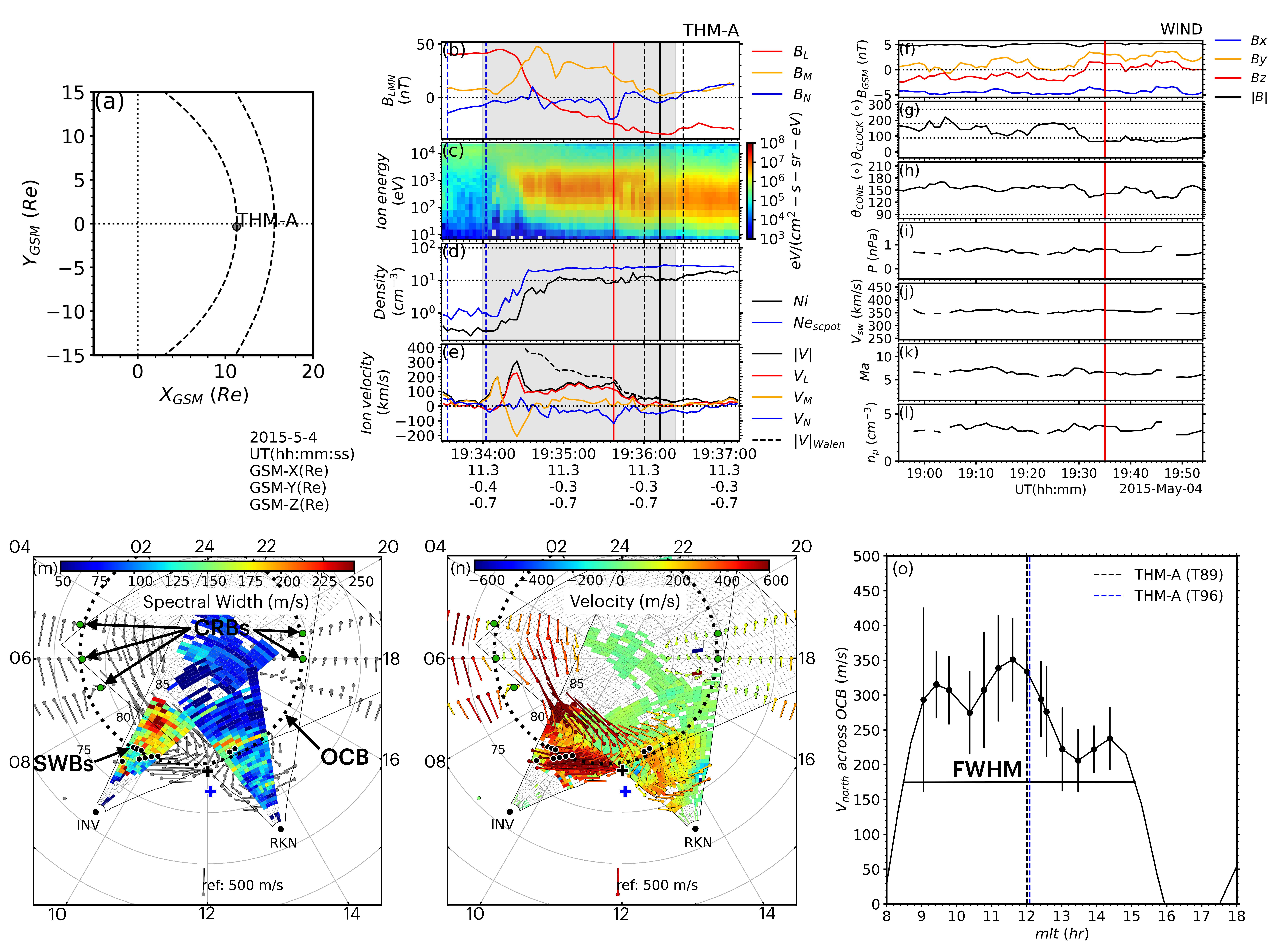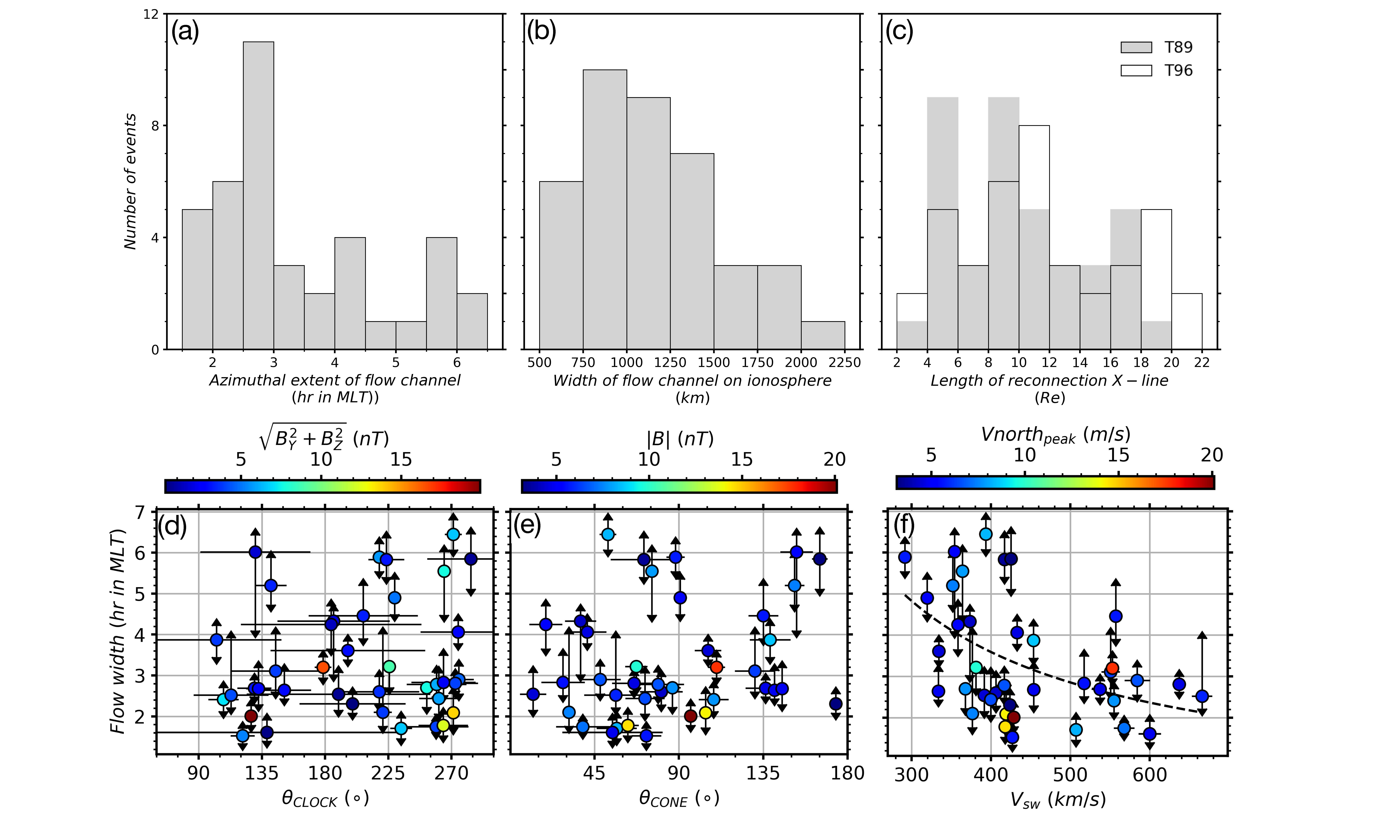
2025 THEMIS SCIENCE NUGGETS
Controlling Factors of the Spatial Extent of Reconnection X-line on Dayside Magnetopause
Krishna Khanal
Department of Space Sciences, The University of Alabama in Huntsville, Huntsville, Alabama, United States
Introduction
Magnetopause reconnection is the dominant mechanism for transporting mass, momentum, and energy into the magnetosphere–ionosphere system. Reconnection has spatial variabilities that modulate the amount of mass and energy that gets transported. The reconnection outflow originating from the X-line has a finite extent in the azimuthal direction, which is referred to as the local time extent of magnetopause reconnection. Determination of the local time extent of reconnection by satellite observations requires either simultaneous crossings of the magnetopause by multiple satellites or continuous observation by a satellite orbiting along the magnetopause boundary. Thanks to ionospheric measurements, reconnection signatures such as Poleward Moving Auroral Forms (PMAFs), cusp precipitation, and fast antisunward flow channels can be comprehensively probed using a combination of ground-based radars and low-orbiting satellites. Studies based on satellite and ground-based observations show that reconnection X-lines can be both spatially extended and spatially patchy. However, it is not known what conditions control the extent. Some studies prior to this work suggested that solar wind speed and Interplanetary Magnetic Field (IMF) orientation might be important controlling factors. However, limited by the number of events under study, no conclusive evidence was presented. In this work, we analyzed 39 magnetopause reconnection events using conjugate observations from the Time History of Events and Macroscale Interactions during Substorms (THEMIS) and the Super Dual Auroral Radar Network (SuperDARN). In situ signatures of reconnection were confirmed by jet detection by THEMIS. SuperDARN is used to measure the associated antisunward flow on the dayside magnetopause. The length of reconnection X-lines is estimated by projecting the ionospheric flow width to the magnetopause. The Advanced Composition Explorer (ACE) and WIND spacecraft were used to analyze solar wind properties upstream of the bow shock.
Results
Figure 1 shows an overview of the space–ground coordinated observation of a reconnection event on 4 May 2015. THEMIS-A traversed the dayside magnetopause near the subsolar region between ~19:34 UT and ~19:36 UT. The magnetopause traversal is indicated by rotation in the magnetic field (Figure 1b) and a change in ion energy (Figure 1c). The satellite observed fast northward ion jets at the magnetopause (Figure 1e). The magnitude and direction of the jets were reasonably consistent with theoretical predictions for reconnection outflow. The reconnection was driven by slow solar wind ( 350 km/s) with a fairly stable southward and duskward directed IMF (Figure 1f,j).
| Figure 1. Overview of a case study on 4 May 2015. (a) Location of THEMIS-A relative to model magnetopause and bow shock. (b)–(e) Magnetic field, ion energy, density, and ion bulk speed from THEMIS-A. (f)–(l) Solar wind parameters: IMF, clock angle, cone angle, pressure, speed, Mach number, and density from WIND. (m)–(n) SuperDARN observations of the Spectral Width Boundary (SWB) and Line-of-Sight Velocity. Vectors show fitted velocity. ‘Plus’ markers show the magnetic footprints of satellites under T89 (black) and T96 (blue). (o) Longitudinal profile of antisunward flow just inside the OCB. |
SuperDARN provided simultaneous observation of plasma dynamics in the high-latitude ionosphere in the Northern Hemisphere. The ionospheric plasma exhibited a typical two-cell convection pattern consisting of an antisunward flow over the polar caps and sunward return flow over lower-latitude regions (Figure 1n). The magnetic footprint of THEMIS-A was within the strong antisunward flow channel on the dayside ionosphere, indicating an association between the in situ and ionospheric counterparts. We measured the width of the reconnection-driven flow channel just inside the Open–Close Boundary (OCB) which was obtained by using two ionospheric proxies: the Spectral Width Boundary (SWB) and the Convection Reversal Boundary (CRB) (Figure 1m). Based on the Full Width at Half Maximum (FWHM), the width of the antisunward flow channel was determined to be 6.6 hr in Magnetic Local Time (MLT). Based on mapping under the magnetic field models T89 and T96, the lengths of magnetopause X-lines in the dawn–dusk direction were 19.5 RE and 17.6 RE, respectively
To investigate the spatial extent of the X-line and possible control factors, we performed a statistical study of 39 events with clear space–ground observations of reconnection. The events were collected after surveying 3 years (2015–2017 inclusive) of dayside magnetopause crossings by THEMIS A, D, and E. We observed a wide variability in the azimuthal extent of X-lines, ranging from ~1.5 hr MLT to ~6.5 hr MLT (Figure 2a). The widths of the flow channels ranged from ~600 km to ~2200 km in the ionosphere (Figure 2b). The corresponding lengths of the X-line ranged from ~3 RE to ~22 RE (Figure 2c). Figure 3 shows the flow width plotted against solar wind parameters, namely, clock angle, cone angle, and bulk speed. The clock angle is the angle between the IMF projection on the vertical plane and the vertical line. The cone angle is the angle between the IMF and the Sun–Earth line. No clear dependence on IMF orientation was observed. Nevertheless, the flow widths are comparatively narrow (~2 hr MLT) for events with strongly dawnward or duskward IMF (Figure 2d). We saw a negative association of the flow widths with the solar wind speed. The majority of the spatially extended events are found during lower solar wind speed conditions, whereas the flow channels were mostly spatially limited during higher solar wind speeds (Figure 2f).
| Figure 2. Histograms showing (a) the azimuthal extent of the flow channels in MLT, (b) the width of the flow channels in the ionosphere, and (c) the length of the reconnection X‐lines in the GSM‐Y direction. |
Conclusion
Magnetopause reconnection has a wide variability in azimuthal extent, ranging from ∼1.5 hr MLT to ∼6.5 hr MLT, corresponding to magnetopause reconnection X‐lines of a few RE to ∼22 RE long in the dawn–dusk direction. Through our first statistical analysis, we showed that reconnection span is negatively associated with solar wind speed. We observed that flow shear in the reconnection outflow direction can be notable during high solar wind speed conditions, potentially playing a role in spatially constraining the X-lines. Further investigation is warranted to confirm the role of velocity shear in limiting the length of X-lines on the dayside magnetopause
Biographical Note
Krishna Khanal is a postdoctoral researcher in the department of space science in the University of Alabama in Huntsville. His research primarily focuses on solar wind magnetosphere interaction and solar wind turbulence.
References
Khanal, K., Zou, Y., Shi, X., Zank, G., Ruohoniemi, J. M., and McWilliams, K. (2025). Controlling factors of the local time extent of magnetopause reconnection: A statistical study. Journal of Geophysical Research: Space Physics, 130(3), e2024JA033392. Please send comments/suggestions to
Emmanuel Masongsong / emasongsong @ igpp.ucla.edu
Please send comments/suggestions to
Emmanuel Masongsong / emasongsong @ igpp.ucla.edu


